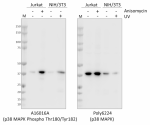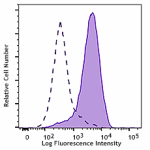- Clone
- A16016A.Rec (See other available formats)
- Regulatory Status
- RUO
- Other Names
- p38α, Mitogen-Activated Protein Kinase 14, MAPK 14, CSBP
- Isotype
- Mouse IgG1, κ

-

Whole cell extracts (15 µg total protein) from serum-starved Jurkat cells untreated (-) or treated with 25 µg/mL anisomycin for 15 minutes (+), and NIH/3T3 cells untreated (-) or treated with UV irradiation (+) (one hour recovery) were resolved by 4-12% Bis-Tris gel electrophoresis, transferred to a PVDF membrane and probed with 0.5 μg/mL (1:1000 dilution) of purified anti-p38 MAPK Phospho (Thr180/Tyr182) recombinant (clone A16016A.Rec) for 2 hours at room temperature. Proteins were visualized by chemiluminescence detection using HRP goat anti-mouse IgG (Cat. No. 405306) at a 1:3000 dilution. Purified anti-p38 MAPK (clone Poly6224) (Cat. No. 622403) was used at a 1:4000 dilution to measure total p38 MAPK protein levels. Western-Ready™ ECL Substrate Premium Kit (Cat. No. 426319) was used as a detection agent. Lane M: Molecular weight marker -

Jurkat cells serum-starved and treated (filled histogram, positive control) or untreated (open histogram, negative control) with 25 µg/mL anisomycin for 15 minutes were fixed and permeabilized using the True-Phos™ Perm Buffer (Cat. No. 425401), and intracellularly stained with 0.125 µg of purified anti-p38 MAPK Phospho (Thr180/Tyr182) recombinant (clone A16016A.Rec) followed by PE goat anti-mouse IgG (Cat. No. 405307).
| Cat # | Size | Price | Quantity Check Availability | ||
|---|---|---|---|---|---|
| 690251 | 25 µg | $141.00 | |||
| 690252 | 100 µg | $329.00 | |||
Mitogen activated protein kinases (MAPK) are a family of highly conserved intracellular kinases that transduce extracellular signals relayed by surface receptors or various types of damage. Three subfamilies exist in mammals, including ERK, JNK, and p38 kinases. Four p38 MAPK family members have been identified: p38a, p38b, p38g, and p38d. p38a is ubiquitously expressed usually at high levels, whereas p38b is expressed at lower levels. The expression patterns of p38g and p38d are more restricted. Most of the functions that are generally ascribed to p38 MAPKs refer to p38a, which is encoded by the MAPK14 gene. The p38 MAP kinase is activated by treatment of cells with proinflammatory cytokines (e.g. TNF and IL-1) or by exposure of cells to environmental stress (e.g. UV radiation and osmotic shock). This activation results in the phosphorylation of residues Thr180 and Tyr182. Over 100 proteins can be directly phosphorylated by p38a and a significant proportion of them are involved in the regulation of gene expression. In addition, the p38a pathway can control at different levels the production of extracellular signaling molecules, such as cytokines, chemokines, and growth factors.
The p38a signaling pathway has dual roles in tumorigenesis. During oncogene-induced tumor initiation and in the early response to carcinogens, p38a mainly acts as a tumor suppressor by maintaining cell homeostasis and eventually inducing cell death. However, p38a function is sometimes altered in the tumor cell so that it favors tumor progression. This might be due to changes in gene expression programs that accompany malignant cell transformation or could be driven by different stimuli available in the microenvironment.
Product Details
- Verified Reactivity
- Human, Mouse
- Antibody Type
- Recombinant
- Host Species
- Mouse
- Immunogen
- Synthetic peptide corresponding to human p38 MAPK phosphorylated at threonine 180 and tryrosine 182
- Formulation
- Phosphate-buffered solution, pH 7.2, containing 0.09% sodium azide
- Preparation
- The antibody was purified by affinity chromatography.
- Concentration
- 0.5 mg/mL
- Storage & Handling
- The antibody solution should be stored undiluted between 2°C and 8°C.
- Application
-
WB - Quality tested
ICFC - Verified
- Recommended Usage
-
Each lot of this antibody is quality control tested by western blotting. For western blotting, the suggested use of this reagent is 0.5 - 1.0 µg/mL. For flow cytometric staining, the suggested use of this reagent is ≤ 0.125 µg per million cells in 100 µL volume. It is recommended that the reagent be titrated for optimal performance for each application.
- Application Notes
-
A16016A.Rec is a recombinant antibody derived from BioLegend clone A16016A (Cat. No. 690202).
This clone is predicted to recognize rat p38 MAPK phosphorylated at threonine 180 and tyrosine 182 due to complete sequence homology between the immunizing peptide and the rat p38 MAPK ortholog. - RRID
-
AB_2910498 (BioLegend Cat. No. 690251)
AB_2910498 (BioLegend Cat. No. 690252)
Antigen Details
- Structure
- 390 amino acids, predicted molecular weight of p38α is 41 kD; molecular weight of other isoforms of p38α range from 29 kD to 35 kD.
- Distribution
-
Cytoplasm and nucleus/Ubiquitously expressed
- Function
- Serine/threonine kinase which acts as an essential component of the MAP kinase signal transduction pathway. MAPK14 is one of the four p38 MAPKs which play an important role in the cascades of cellular responses evoked by extracellular stimuli such as proinflammatory cytokines or physical stress leading to direct activation of transcription factors.
- Interaction
- Component of a signaling complex containing at least AKAP13, PKN1, MAPK14, ZAK and MAP2K3. Binds to a kinase interaction motif within the protein tyrosine phosphatase, PTPRR. Interacts with SPAG9 and GADD45A. Interacts with CDC25B, CDC25C, DUSP1, DUSP10, DUSP16, NP60, SUPT20H and TAB1. Interacts with casein kinase II subunits CSNK2A1 and CSNK2B. Interacts with PPM1D. Interacts with CDK5RAP3; recruits PPM1D to MAPK14 and may regulate its dephosphorylation.
- Biology Area
- Cell Biology, Signal Transduction
- Molecular Family
- Phospho-Proteins, Protein Kinases/Phosphatase
- Antigen References
-
- Sosa MS, et al. 2011. Clin Cancer Res. 17:5850-7
- Igea A and Nebreda AR. 2015. Cancer Res. 75:3997-4002
- Wagner EF and Nebreda AR. 2009. Nat Rev Cancer. 9:537-49
- Hui L, et al. 2007. Cell Cycle. 6:2429-33
- Bulavin DV and Fornace AJ Jr. 2004. Adv Cancer Res. 92:95-118
- Gupta J, et al. 2014. Cancer Cell. 25:484-500
- Otsuka M, et al. 2010. Gastroenterology. 138:1255-65
- Gene ID
- 1432 View all products for this Gene ID
- UniProt
- View information about p38 MAPK Phospho Thr180/Tyr182 on UniProt.org
Other Formats
View All p38 MAPK Phospho Reagents Request Custom Conjugation| Description | Clone | Applications |
|---|---|---|
| Purified anti-p38 MAPK Phospho (Thr180/Tyr182) Recombinant Antibody | A16016A.Rec | WB,ICFC |
| PE anti-p38 MAPK Phospho (Thr180/Tyr182) Recombinant Antibody | A16016A.Rec | ICFC |
| Alexa Fluor® 488 anti-p38 MAPK Phospho (Thr180/Tyr182) Recombinant Antibody | A16016A.Rec | ICFC |
Compare Data Across All Formats
This data display is provided for general comparisons between formats.
Your actual data may vary due to variations in samples, target cells, instruments and their settings, staining conditions, and other factors.
If you need assistance with selecting the best format contact our expert technical support team.
-
Purified anti-p38 MAPK Phospho (Thr180/Tyr182) Recombinant Antibody

Whole cell extracts (15 µg total protein) from serum-starved... 
Jurkat cells serum-starved and treated (filled histogram, po... -
PE anti-p38 MAPK Phospho (Thr180/Tyr182) Recombinant Antibody

PBMCs untreated (negative control, open histogram), or treat... -
Alexa Fluor® 488 anti-p38 MAPK Phospho (Thr180/Tyr182) Recombinant Antibody

PBMCs either untreated (negative control, open histogram) or...
